This leadership & guide training course ventures into the central Andes to attempt a summit of Aconcagua. It is one of the seven summits and the highest peak outside of Asia reaching an altitude of 22,841'. This comprehensive expedition course focuses on teaching students to be safe, efficient, knowledgeable and confident outdoor leaders in a high altitude mountain environment.
Course Photos
-
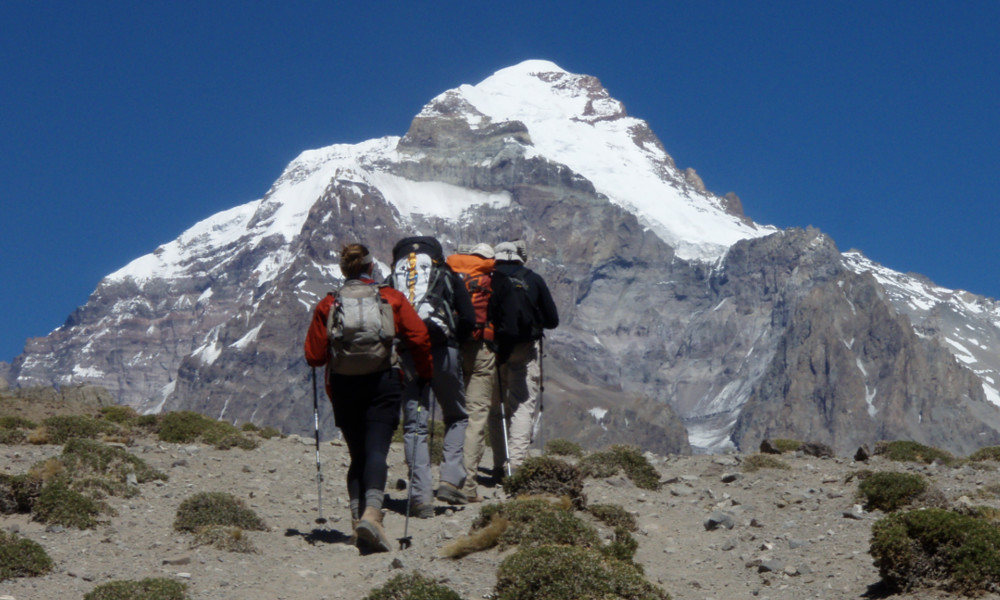
 Day 3, ascending towards Plaza Argentina
Day 3, ascending towards Plaza Argentina
-
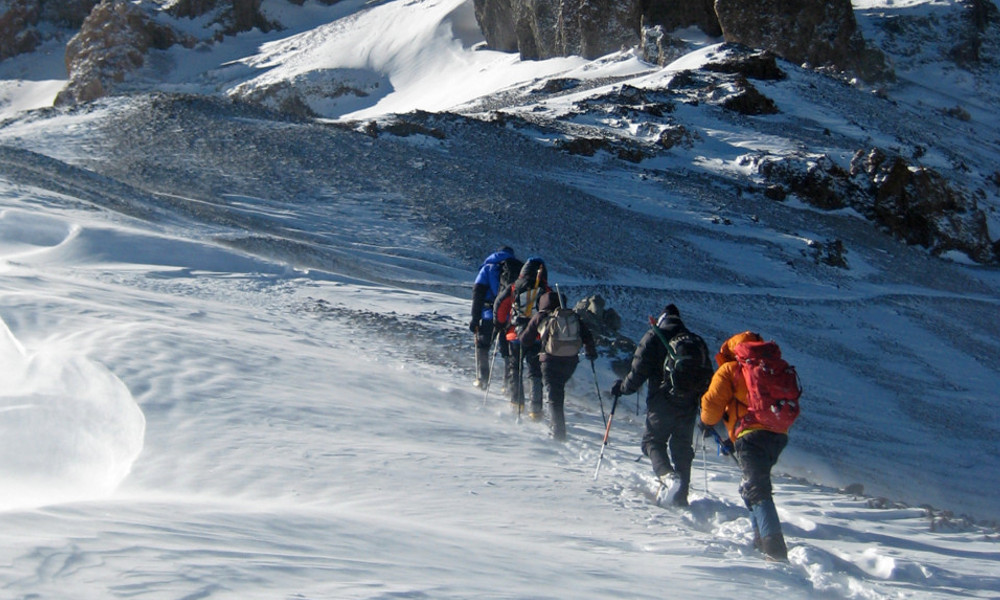
 Summit day on Aconcagua
Summit day on Aconcagua
-
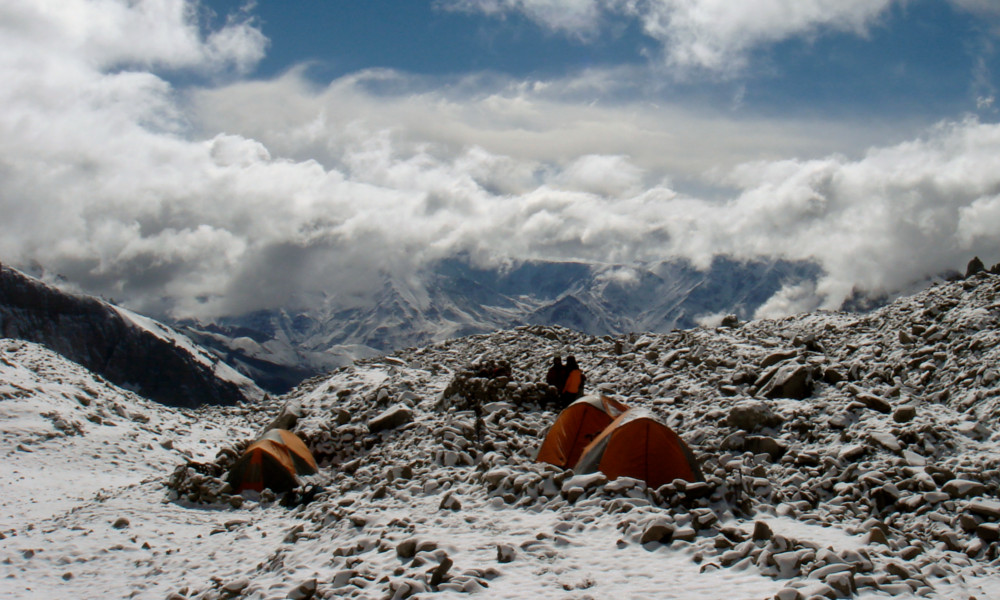
 Fresh snow at camp 2 on Aconcagua
Fresh snow at camp 2 on Aconcagua
-
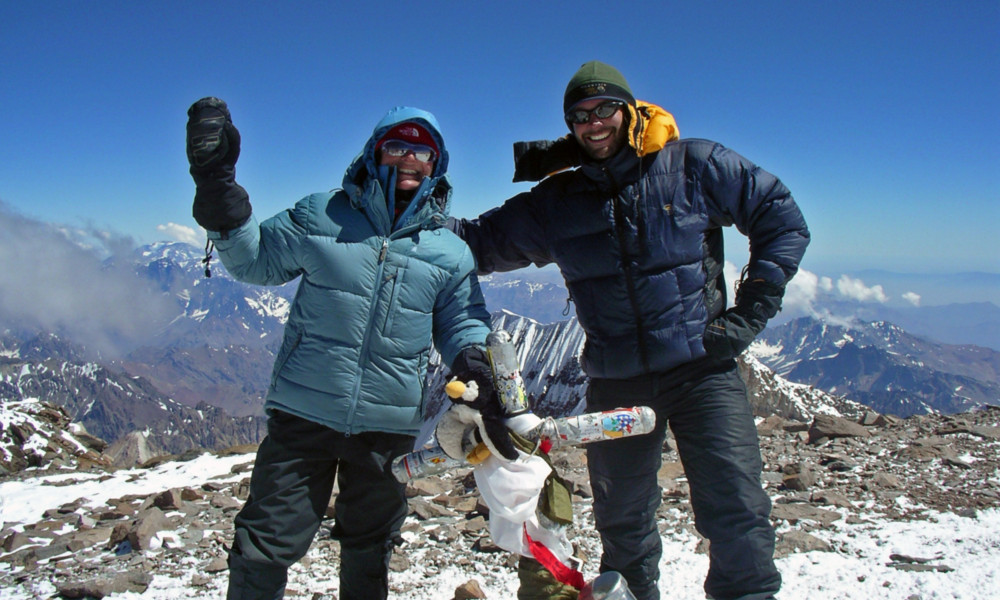
 All smiles on top of Cerro Aconcagua
All smiles on top of Cerro Aconcagua
-
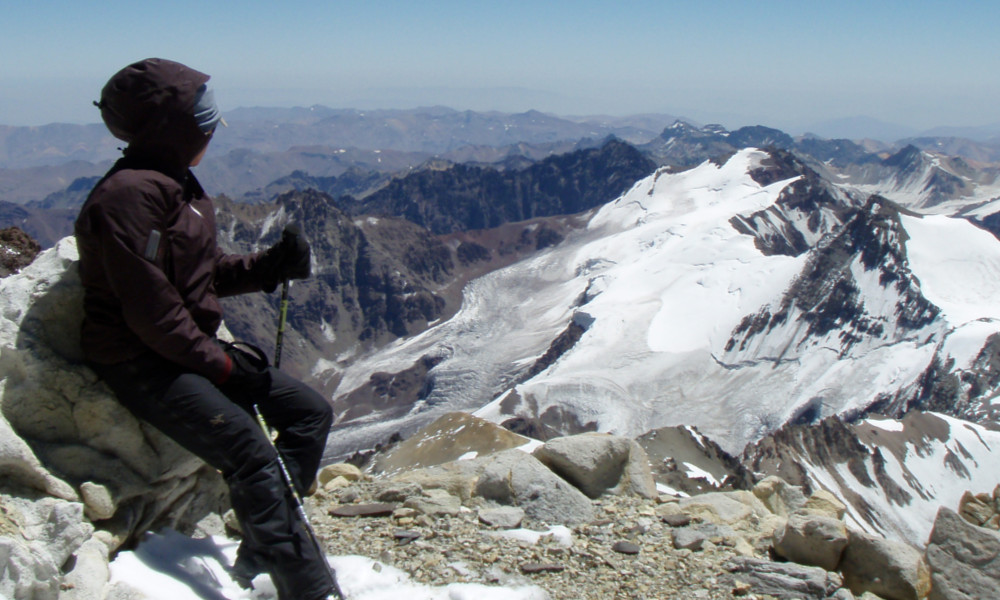
 Contemplation high on the mountain
Contemplation high on the mountain
-
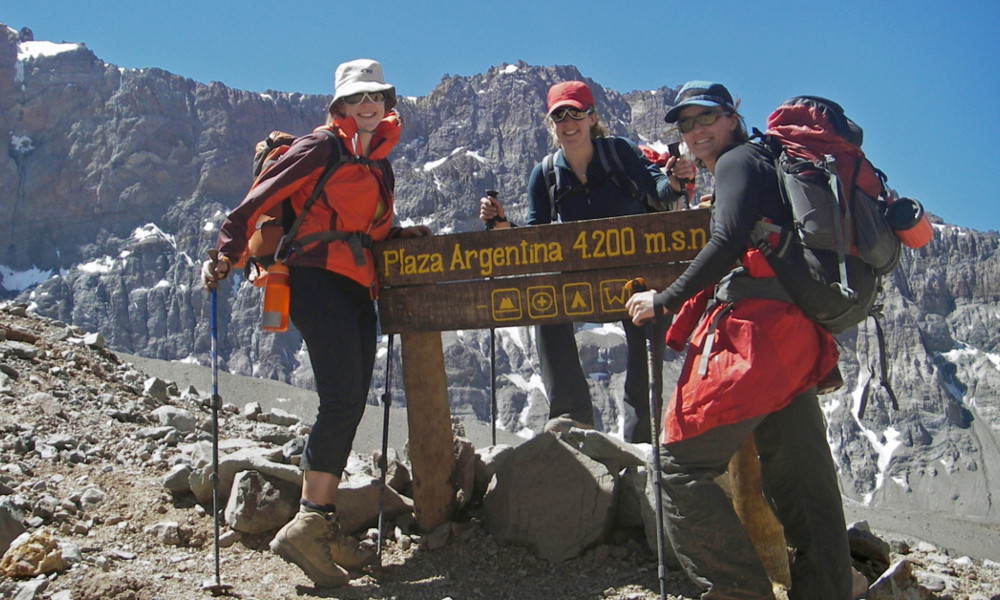
 Welcome to Plaza Argentina
Welcome to Plaza Argentina
-
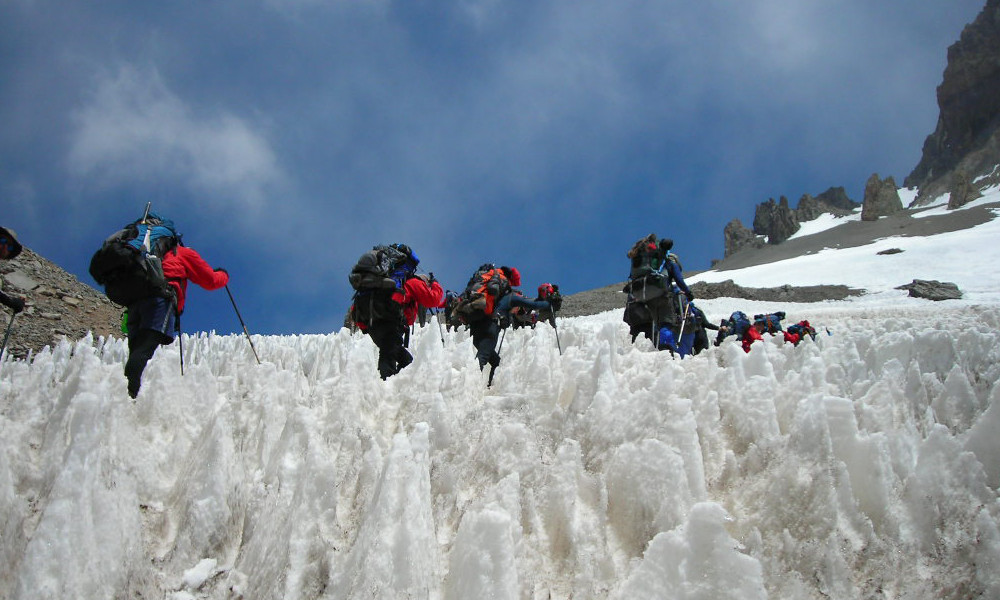
 Navigating through penitentes en route to Camp 1.
Navigating through penitentes en route to Camp 1.
Course Notes
Meeting Point: Mendoza, Argentina
Destination: Aconcagua
Duration: 20 days
Price: $5800 (+ tax, in USD)
Activity Type: Mountaineering
Season: January, February, December
Instructor/Student Ratio: 1 to 4
Technical Skills: high altitude medicine, ice axe, crampon use
Leadership Skills: expedition planning, group management
Max group size: 8 students
Difficulty Level: 5 out of 5
Paperwork Required: Registration, Health Form, travel insurance, Land Based Activity Waiver
Valid passports required
CLICK HERE FOR DATES & PRICES
Trip Description
Aconcagua (22,829 ft) is located in the central Andes of Argentina near the border with Chile. It is one of the seven summits and is the only peak outside of Asia that reaches this high altitude. Aconcagua is a focal point of activity in the international outdoor recreation industry. It involves high quality, non-technical climbing in a pristine environment. IWLS director Sean Gaffney pioneered the first ascent of the Guanacos route in 1996.
Picture yourself waking up at first light to start melting snow for water, trekking among a field of penitentes, and assessing the groups’ acclimation trends using a pulse oximeter. Aconcagua offers a unique educational opportunity for students seeking the skills and experience of participating in a high altitude climbing expedition in a foreign country. This comprehensive mountaineering course is the perfect setting to achieve your goals whether you are looking to become a professional guide, hone your technical abilities for personal adventures, or expand your leadership skills. It focuses on teaching students to be safe, efficient, knowledgeable and confident outdoor leaders in a high altitude mountain environment.
Our route moves up the northeast side of the mountain and is independent from other routes on the mountain until high camp at 20,000 feet, where it rejoins the normal route for summit day. We use four camps that are well spaced at 2,000-foot intervals, an ideal distance for helping everyone acclimatize, one of the most important factors in being safe and successful! Our itineraries are designed to provide individuals with a positive high altitude experience. They include ample time for rest, weather and acclimatization days. Extra days also give us the opportunity for learning about leadership and guiding at high altitude. We normally use four camps above Base Camp, which dramatically increases the safety and success of our students because of better acclimatization. This also makes the carries between camps less than 2,000 vertical feet, another big factor in being well acclimatized!
Argentina: Argentina is a beautiful, lively, country located at the bottom of the South American continent. It is home to many diverse climatic and geographical regions. Aconcagua and the beautiful Matienzo Valley are located on the country's western edge, near its border with Chile.
Mendoza: Mendoza is the starting and ending place for our trip. It can easily be reached by daily flights from both Buenos Aires and Santiago. Mendoza is a colorful city of approximately 500,000 people full of interesting history, markets and parks. It is located in the heart of Argentina's wine country and the climate is predominantly hot and sunny!
Aconcagua (22,829 ft): One of the Seven summits, and highest point in the Western and Southern Hemisphere. It offers a formidable challenge and a rewarding expedition.
Difficulty: All trekking is moderate, progressing to difficult at higher elevations. The trail is rocky all the way to the summit, unless there is snow. Trekking days are usually four to eight hours long, in some cases climbing up to 2500 feet in a day. In general the weather is warm and sunny on the approach hike days! The climbing is basic level scrambling, with potential for basic snow/ice climbing, depending on the current conditions. There is ample opportunity on the course to learn and brush up on the technical skills required for the climb.
Our Instructors: IWLS instructors and guides are highly-trained professionals recognized as some of the best in their field. They have a wealth of experience from guiding throughout Alaska, Canada, and the world. They genuinely enjoy sharing their knowledge of the outdoors in the wild places that they love. Their experiences and leadership help our students to have the best possible experience during their course. Students' safety, education, and enjoyment are their primary goals. The International Wilderness Leadership Schools’ educational model nurtures leadership development and creates an awareness of the guiding mentality that is essential for leading safe, fun adventures in the mountains. The combination of technical skills training, experiential education and practical leadership experience make the IWLS curriculum world-class. Our Aconcagua instructors have extensive experience on the mountain. Their skill and knowledge insure a safe, successful, and fun trip. We also limit the size of our groups and maintain a small student to instructor ratio. The itineraries and camps that we use are designed to provide the best experience on this challenging and rewarding trip!
Experience Level: No previous experience is necessary for this course. However, with a desire to learn and an enthusiasm for adventure, you’ll develop the skills necessary for a lifetime of wilderness exploration. Previous expedition camping and/or high altitude experience is recommended.
Certifications: Upon completion of the 20-day Aconcagua expedition leadership course, students will be eligible for the following certifications:
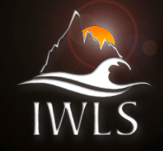
Mountaineering Guide Training Certificate of Completion
Course Itinerary (printable PDF)
Day 0: Arrive in Mendoza. An instructor will meet you at the airport with an IWLS sign.
Day 1: Mendoza to Penitentes. In the morning we will get our park service climbing permits, and go over risk management considerations for expedition planning. Then we travel by private passenger van for approximately 3 hours to the winter resort community of Penitentes where we will spend the evening. Penitentes, situated at approx. 9,000 ft., is a good elevation to begin acclimatizing. After getting situated in our rooms at the lodge we will do a check of everyone’s equipment, pack clothing and gear for the next morning, and pack bags for the mules. Dinner is in the lodge.
Day 2: Penitentes to Pampa Lena. After breakfast in the lodge, we will trek for approximately four hours up the Vacas valley to our first camp at Pampa Lena (9,200 ft.). The valley is spectacular and the hiking is in a warm, high Andean landscape.
Day 3:Pampa Lena to Casa Piedra. After packing up in the morning we will use a mule to ferry us across the Vacas River. Hiking time is approximately six hours to our camp at Casa Piedra (11,000 ft.). The deep valleys open up as we travel forward, and we get our first views of the mountain.
Day 4: Casa Piedra to Base Camp. Hiking time is approximately eight hours to our Base Camp (12,800 ft.). There is a lot of opportunity to see wild guanaco, a relative of the llama, throughout the day. We also have beautiful views of the Vacas Glacier and all of the glaciers in the upper Vacas valley.
Day 5: Rest/Acclimatization day
Day 6: Carry Equipment and Supplies to Camp 1 (14,800 ft.). Hiking time is approximately six to eight hours round trip.
Day 7: Rest/Acclimatization day
Day 8: Move to Camp 1. Hiking time is approximately four to six hours. Camp 1 has spectacular views of the upper mountain.
Day 9: Rest/Acclimatization day
Day 10: Carry Equipment and Supplies to Camp 2 (16,000 ft.). Hiking time is approximately six to eight hours round trip.
Day 11: Move to Camp 2. Hiking time is approximately six to eight hours.
Day 12: Rest and Acclimatization. Mid-course evaluations: Lead instructors will assess participants’ level of involvement and assessment rubrics associated with the IWLS curriculum. These, in conjunction with peer evaluations, allow participants to receive positive feedback and develop awareness in regards to fulfilling the requirements to receive certification as an outdoor leader.
Day 13: Carry Equipment and Supplies to Camp 3 (20,000 ft.). Hiking time is approximately eight hours round trip. High Camp is located
at White Rocks on the North Ridge. It is an outstanding high camp that is one of the best protected on the mountain. It is less crowded and more sanitary than other high camps, and its placement saves an hour of travel time on summit morning relative to the regular high camp on the normal route.
Day 14: Move to Camp 3 (High Camp- Cholera). Camp 3 is at approximately 20,000 ft. and is located just below the Polish Glacier. We traverse from Camp 2 to meet up with the upper portion of the Guanacos route and Camp 3. White Rocks possesses the excellent combination of being high enough to keep the length of summit day to an appropriate duration, without being too high and having the increased likelihood of sleeping poorly/difficulty with altitude. The next protected spot for a high camp is much further up and it is too high to sleep well there. Camp 3 offers breathtaking views of many of the highest peaks of the Andes!
Day 15: Summit Day! We are up early to prepare. Summit day is usually eight to fourteen hours. It is a demanding day, but climbers are rewarded with stunning views across the Andes in all directions. Don’t forget your camera!
Day 16 - 17: These days are included to accommodate time for additional acclimatization/rest, and weather days. These extra days are built in to provide the best possible conditions for each individual to summit. Ample contingency days are important to accommodating changing individual and group needs. In the last few days of the course we will have final peer and instructor evaluations. Students will be evaluated on their understanding and completion of the IWLS curriculum.
Day 18: High Camp to Plaza Mulas. We will descend from our High Camp to Plaza Mulas, the base camp for the normal route. We carry all of our equipment in one load for the 6,000 foot descent.
Day 19: Plaza Mules to Penitentes. We hike for approximately eight to ten hours down the Horcones Valley to the trailhead. We use mules to help carry the majority of our loads to Punta de Vacas. The Horcones Valley is quite different from the Vacas valley that we use for our approach. It is interesting to see both sides of the mountain. By hiking back out from the mountain this way we complete a circumnavigation of Aconcagua! There is a ranger station at the trailhead where we will check out of the park, and meet our ride back to lodge in Penitentes. We plan to stay the night at the lodge in Penitentes, but it is sometimes possible to arrange for transportation back to Mendoza that same evening.
Day 20: Penitentes to Mendoza. After a good breakfast in the lodge we will travel by private passenger van back to Mendoza. In the evening we like to have a celebratory dinner in one of Mendoza’s many outstanding restaurants.
Day 21: Flights home.
*Aconcagua is a summit oriented learning opportunity. Actual course duration will be a function of weather, acclimatization, objectives accomplished, and the rate at which the team absorbs the IWLS course curriculum. If for any reason the course ends early, students are responsible for the associated costs of returning to Mendoza early.
IWLS General Curriculum outlines the essential components for effective outdoor leadership. Here are a few points that your course will focus on.
- Leadership: We not only exemplify leadership – we teach it and implement it. Students will have
opportunities to lead the group through a variety of activities, objectives, and responsibilities. - Safety and Risk Management: Safety is always our #1 consideration. As the course progresses, students
will develop an awareness to appropriately assess risk and make safe decisions in and out of the field. Especially as it applies to high altitude. - Expedition Behavior and Group Dynamics: Because this course is a true wilderness expedition,
interactions between group members need to be supportive and contribute to the efficacy of the group. The daily
dynamics of the group, combined with guided instruction, will teach students not only how to be a member of a cohesive
team, but how to influence and lead an expedition. - Environmental Ethics: As adventurers in some of the most pristine environments on the planet, it is
our duty to respect the natural world. All of our courses practice and teach Leave No Trace® principles. - Communication Skills: Speaking in public, managing a personal conflict, or leading a group in the
wilderness - all of these situations require effective communication. Students will gain confidence in their
communication abilities while developing personal leadership styles during this course.
The IWLS Mountaineering Curriculum is built from countless expeditions on Aconcagua, in Alaska, and around the world. You’ll learn how to be a competent and proficient mountaineer in a variety of different environments. Below are some topics we’ll cover:
- Subjective Hazards: Among other things, dehydration, fatigue and personal pride can be detrimental to group safety. Learn how to implement measures to mitigate these potential hazards.
- Short Roping: Learn different applications of short roping technique and times and places to utilize it.
- Altitude Considerations: Aconcagua reaches heights above 22,000 feet. Learn how to recognize signs and symptoms of acute mountain sickness, and steps to take to avoid it. We’ll also discuss the most effective treatment for all altitude illnesses: descent.
- Timing: In the mountains, timing is everything: when to leave camp, when to turn around, and when to push for the summit. Time management is a critical component of safe travel and plays into many aspects of mountaineering.
- Travel Techniques: Course instruction will help you discover ways to safely maximize your efficiency,
whether hiking down a well-beaten path or traversing an exposed ridge. - River and Stream Crossings: In river crossings, attention to detail and safety is paramount. Students
will learn and practice safe techniques for wading across a small stream or doing a Tyrolean traverse across a raging
river. - Stoves and Campfires: The ability to repair a broken stove, make an emergency fire after being
submerged in an icy river, and melt snow efficiently for water are key components for leading a group in the
wilderness. - Route Finding and Navigation: The Donjek Route often has no obvious trail. Students will learn
important fundamentals for route finding, using a compass, and navigating in order to negotiate this remote terrain. - Camp Skills Learn about the tents we'll be utilizing, how to organize our kitchen and keep our food
secure and appropriately protected from bears and other wildlife.
The IWLS International Curriculum is designed to provide students with a fundamental understanding of planning and leading expeditions in foreign countries. Here are just a few topics that will be covered:
- Cultural History: As visitors to this remarkable place, we place a premium on being respectful and learning about the local culture and history.
- Trip Preparation: Logistics in a foreign country can be complex and tenuous. You’ll take part in shopping at the local market, arranging transportation, and securing permits in preparation for your expedition on Aconcagua.
Trip Documents:
- Course Overview- Printable detailed course overview & itinerary.
- Equipment List - Overview of personal clothing and equipment that you'll need for this course.
- Registration Form - Outlines policies, and essential information. One required per participant.
- Health Form - This form enables our guides to have accurate health information in the event of an emergency.
- Land Based Activity Waiver - One required per participant. Guests under the age of 18 may go on one form.
- Travel Info - Helpful information on how to get to/from Argentina.
What is included in the course price:
- Expedition gear - group camping equipment, tents, stoves, etc...
- Expedition food - all food while out in the field.
- Transportation during trip - departure and return to Mendoza.
- Professional instructors - Our leaders have extensive knowledge of the area and a passion for leading in wild places.
Students are responsible for the following:
- Personal clothing & equipment - review the equipment list included under "Documents"
- Food and Lodging in Mendoza - We are happy to recommend our preferred options.
- Travel insurance - travel insurance is required for all international programs with IWLS.
- Airfare & travel to course location - review the "Travel Information" under "Documents" for more details.
- Reviewing course policies - please reference our policies page for policies regarding payment, cancellations, refunds and student responsibilities.
- Gratuities
To Book your adventure, follow the steps below:
- Please call to confirm availability at 1-800-766-3396 or fill out an online form to request more information:
- Place a deposit of $500 or 25% of trip cost (whichever is less) to reserve your spot: this can be place over the phone by credit card, check in the mail, or through our payment gateway.
- Once you've reserved your spot, you'll receive a welcome packet with all the necessary registration forms and trip information.
- Be sure to submit all trip registration documents at least 45 days prior to your course. This includes information on your arrival/departure, lodging, dietary, and medical information.
Feel free to call or email anytime if you have questions about your upcoming trip. Our team is excited to help you prepare for your adventure!
Student Comments:
I had an amazing trip with you guys! Harry (our lead instructor) was patient, thoughtful, and helped break down the decision making process that went into tackling Aconcagua. Summit day was challenging but rewarding and I'll never forget the incredible feeling of reaching the summit! - Derek T.
